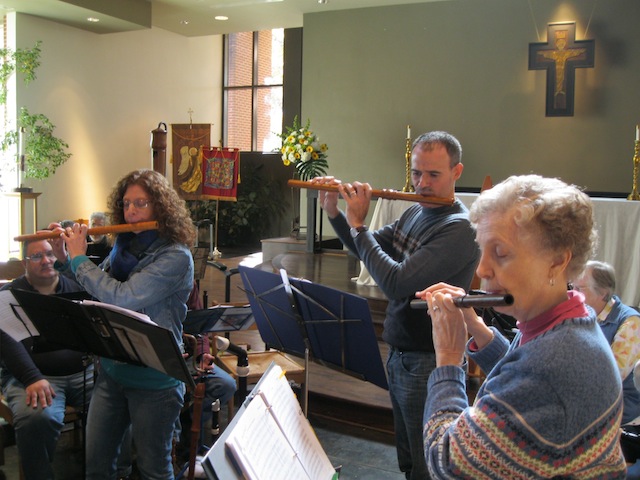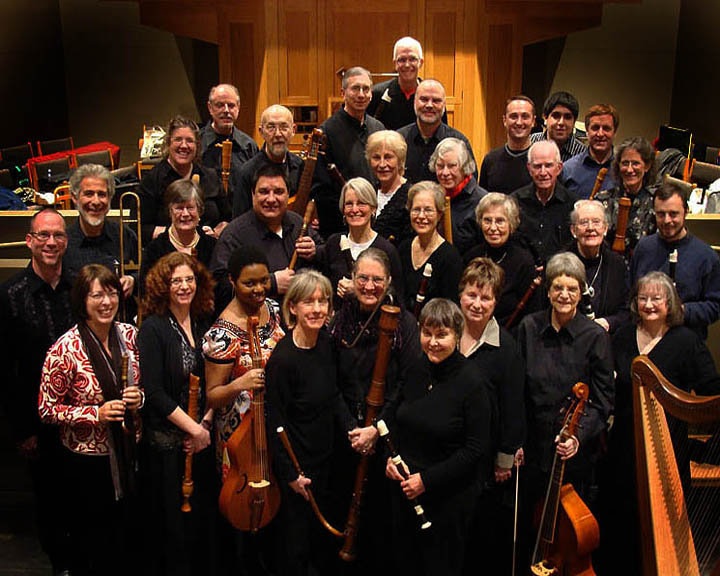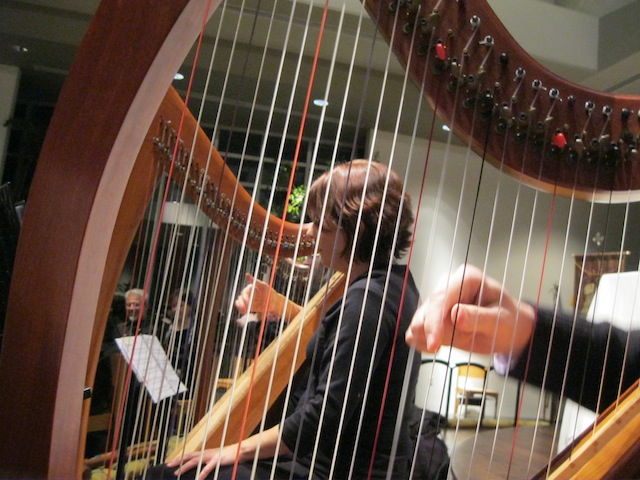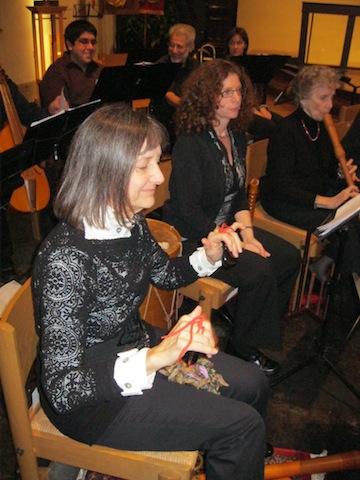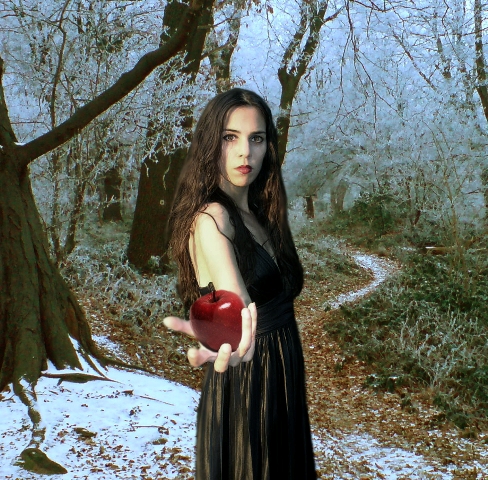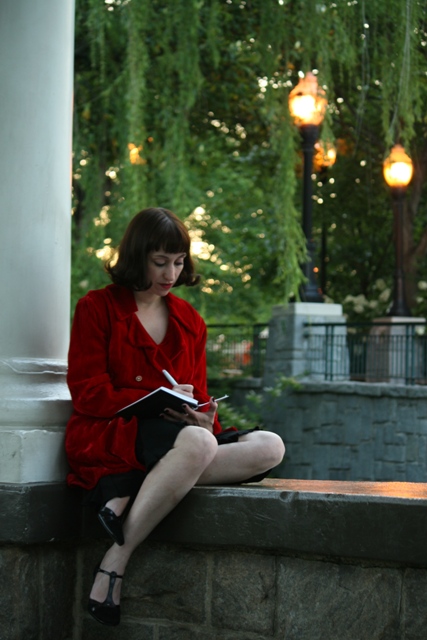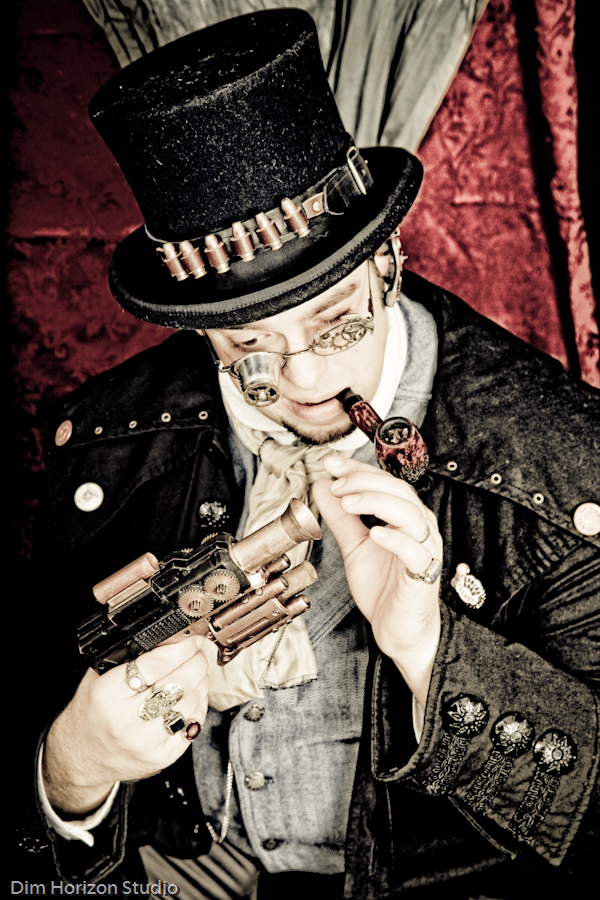 When The Artifice Club presents the 2nd annual Mechanical Masquerade: A Paranormal Fantasy this Saturday Nov. 12 at Blue Mark Studios, a renovated 110-year-old church, they couldn’t have picked a better judge for their ghost story contest than S. J. Chambers, co-author with Jeff VanderMeer of the critically acclaimed THE STEAMPUNK BIBLE (published by Abrams Image this spring). S.J., you see, suffers from Poepathy, a dread affliction whose symptoms include “daydreaming…reveries that include black birds, scents of an unseen censor or aberrant alliterative applications.” She contracted it, she says mournfully (or enthusiastically, depending on your point of view), from excessive contact with the works of seminal American horror author, Edgar Allan Poe, on whose works she has penned a frightful quantity of essays and journalistic works.
When The Artifice Club presents the 2nd annual Mechanical Masquerade: A Paranormal Fantasy this Saturday Nov. 12 at Blue Mark Studios, a renovated 110-year-old church, they couldn’t have picked a better judge for their ghost story contest than S. J. Chambers, co-author with Jeff VanderMeer of the critically acclaimed THE STEAMPUNK BIBLE (published by Abrams Image this spring). S.J., you see, suffers from Poepathy, a dread affliction whose symptoms include “daydreaming…reveries that include black birds, scents of an unseen censor or aberrant alliterative applications.” She contracted it, she says mournfully (or enthusiastically, depending on your point of view), from excessive contact with the works of seminal American horror author, Edgar Allan Poe, on whose works she has penned a frightful quantity of essays and journalistic works.
Lately though, S.J.’s journalistic adventures have sailed towards Steampunk, a fast-growing international movement whose participants dream of an alternate world powered by steam technology and resplendent with airships, corsets, goggles, mad scientists and other fantastical wonders of a Jules Verne-ian nature. Lavishly illustrated, THE STEAMPUNK BIBLE is the first definitive guide to the wildly, weirdly imaginative literature, art and costuming of the subculture, which has a vibrant chapter here in Atlanta. A Tallahassee resident (she also treated us to the Cute and Creepy art exhibit review here), SJ also will be signing that esteemed tome at the Mechanical Masquerade, The Artifice Club’s most elaborate event yet—planned to play out like a story itself in which a supernatural-themed masquerade ball is staged on a magical rift accidentally created by one infamous Montague Jacques Fromage whle experimenting with a curious invention in service of her majesty Queen Victoria. And yes, masks are not just encouraged but required (come unfashionably without one, and we’re told you may be asked to leave or to purchase one from the lovely Dread Sisters). The fantastical festivities start with afternoon seminars on topics such as Steampunk Burlesque (see this week’s Kool Kat feature on Indigo Blue here). Then the main event runs from 5 p.m. to way past midnight and features a bazaar, libations, costume contest and performances by an eclectic ensemble of talent including the Mezmer Society, Doc Volz and his Steampunk Trunk, The Ghosts Project, Vauxhall Garden Variety Players and the Fantasia de Mode Fashion Show presented by The Steampunk Chronicle.
ATLRETRO asked S.J. to demystify steampunk for the uninitiated, tell us what she learned about steampunk abroad on her recent book tour to England and France, and tease us with a sneak peek into her role in the Paranormal Fantasy. She not only kindly obliged, but then some…
What’s the origin story behind THE STEAMPUNK BIBLE (Abrams Image) and how you personally became involved?
It did some editorial work for Ann and Jeff VanderMeer with [surrealist flash-fiction anthology] LAST DRINK BIRD HEAD and some other miscellaneous projects, so my role with THE STEAMPUNK BIBLE began as an editorial assistant. However, Jeff loved what I was doing, and saw how much I was getting into the project, that he asked me to contribute to the writing. One thing lead to another and we were co-authors. I can’t say enough what a great experience it has been to work side-by-side with Jeff. He’s full of wisdom and one of the best writers alive, imho.
 Why are you excited to be attending THE MECHANICAL MASQUERADE: A PARANORMAL FANTASY and what will you be up to while you’re here?
Why are you excited to be attending THE MECHANICAL MASQUERADE: A PARANORMAL FANTASY and what will you be up to while you’re here?
There are several reasons why I am excited about this event. First, I have an extreme case of Dance Party deficiency, so I can’t wait for DJ Doctor Q to start spinning at midnight. Second, I’m excited about wearing a costume, which I don’t usually do. The clothes I wore on tour are pretty much what I wear normally, even the more Pre-Raphaeliteish pieces, so this is my first true sojourn into Steampunk chic. Not sure how great it’ll be, as everything I touch seems to turn Regency, but it should be fun.
But vanity aside, what I am REALLY excited about is the ghost story contest that I am judging. From 8 p.m. to 9 p.m., I am challenging guests of The Mechanical Masquerade to scare me! Contestants will have five minutes to spin a paranormal yarn—doesn’t have to be gruesome horror, but must have something of the unexplainable and strange. If participants are reading this, I’ll give them a clue as to what endears me most. I love stories—and this goes for any type of story really—that strike me emotionally. So, if you make me split my petticoat with laughter, or drown my veil in tears, you’ll get a lot of bonus points. Being the Poepathist that I am, some of my favorite tales involve haunted houses and dead lovers, and the more monsters the merrier.
In any case, we will have lots of prizes for winners, including a first prize of signed copies of THE STEAMPUNK BIBLE and Ann and Jeff VanderMeer’s wonderful, new anthology THACKERY T.LAMBSHEAD’S CABINET OF CURIOSITIES, which I have a sundry tale in, and a $25 gift certificate to Octane Coffee. Not bad for five minutes. If you don’t want to vie for a copy of THE STEAMPUNK BIBLE via the competition, they will be available for purchase and signing throughout the night.
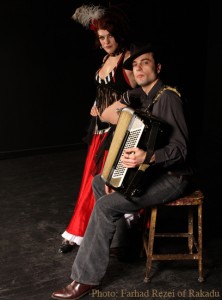
The Mezmer Society. Photo credit: Farad Rezei of Rakadu.
THE STEAMPUNK BIBLE seems to be thriving in a time when books and authors in general are having a tough time. You even had a whirlwind signing tour which took you through New England and to England and France. What’s the secret to its success and why is steampunk so popular right now?
I would say publishing is in a state of transition right now, thanks to e-publishing, and in trying to figure out what that means in the grand scheme of things, on top of the recession, authors and books are having to work double-time to stay afloat. I definitely know that I, Jeff, our editor Caitlin Kenney, our publicist Amy Franklin, and the wonderful people at Abrams, as well as our contributors, believed very strongly and worked really hard on promoting this book. So, I attribute a lot of the success we’ve had to our collective sweat and tears.
The fact that, in this burgeoning world of two-dimensional and grey e-books, the THE STEAMPUNK BIBLE is very tactile and visually pleasing hasn’t hurt. This is a book with a lot of textual as well as visual content, and it invites people to peruse it in both ways, which really appeals to readers. I think this attraction ultimately ties into the same technological fatigue that is making the Steampunk spirit very resonant: the world is tired of being spoon-fed culture and knowledge. We need Steampunk in our lives because it promotes imagination and ambition, it promotes awareness of how things work and also sustainability. People think of Steampunk as a fashion fad or a science fiction trend, but it is an umbrella term for a lot of reactionary and revolutionary philosophies on modern life, which we try to touch on in the book.
Speaking of England and France. You even went to a steampunk convention over there, didn’t you? How do English and French steampunks or steampunk fans differ from the American variety?
While I did an event in London, and an event in Paris, I am afraid I didn’t make it to the Weekend at the Asylum in Lincoln. Towards the end of planning the Europe Tour, an assignment in Paris came up, so I had to take those few extra days to make sure I had time to work on it. I was sorry to miss it, as I had just met Jema Hewitt and Kit Cox who were going, and I would have loved to spend more time with them, as well as meet some of the U.K. Steampunk luminaries like John Naylor and Professor Elemental.
The differences between U.K., French and U. S. Steampunk are subtle. U.K. tends to be more Victorian-oriented because that’s where she reigned and that’s their direct history. However, I think we over here in the states misunderstand U.K. Steampunk as nostalgists ignoring skeletons in the Empire closet, and I found that to not be true. At the Last Tuesday Society event, there was a lot of interest in multicultural Steampunk, and I think that dialogue is just waiting to burst through the gates there. French Steampunk was very interesting because a lot of its participants are interested in CosPlay, but there aren’t really any venues for that. The fine folks of French Steampunk, like Morgan Guery and Franck Gouraud are trying to promote conventions around France, and I think that will contribute to a very strong and cohesive scene there. Also, just like U.K. Steampunk operates within their history, so do the French Steampunks. Queen Victoria and the Empire is irrelevant, and while we had our Civil War, they were dealing with their own strife with the Paris Commune and the reign of Napeoleon III. It has led to a lot of beautiful and innovative art like Sam van Olffen, Futuravapeur and Anxiogene.

The “Sultan’s Elephant” at The Machines of the Isle of Nantes exhibit, Nantes, France. Photographed in 2009 by Yann Langeard - Le Chatrou Electrique.
What makes a literary work, piece of art, costume steampunk at the most basic level and do goggles have to be involved?
Ha! No goggles do not need to be involved, nor necessarily cogs, nor gears. Tor editor Liz Gorinsky explained Steampunk best when she compared it to porn—“I know it when I see it”—which perfectly encapsulate the difficulties of defining this aesthetic. I know I should have an elevator pitch-like answer for this, but the real answer is too complex. It is why we wrote a book about it.
As just flipping through the book will show, there are a lot of characteristics that bind artists together under the umbrella Steampunk—like the iconic goggles, a retro ambiance, gears, cogs, rayguns, hoop skirts, leather corsets, mecha animals, steel and steam—but it is also an ever-changing and evolving aesthetic that can feature a lot of versatile and disparate characteristics informed by cultural history, and even era. What was once a retro-futurist movement that looked only as far back as the 19th century has participants looking back even further, evaluating our present on all aspects of past failures and successes. The Steampunk of today will not be the Steampunk of tomorrow.
To the uninitiated person who wants to experience steampunk, what three authors could they read and get a good sense of what it’s all about?
Jules Verne, Cherie Priestand Scott Westerfield. I know I am cheating with Jules Verne, but I feel like if you don’t understand Verne’s world, you are missing a key part of Steampunk history and its context. Also, since I’ve already cheated once, it won’t hurt to cheat again. I would say Steampunk newcomers would find a lot of guidance in Ann and Jeff VanderMeer’s two STEAMPUNK anthologies, as they do a wonderful job of displaying the movement’s full literary spectrum.
What was your favorite part about researching THE STEAMPUNK BIBLE?
Getting to talk with artists, makers and writers about their craft, and finding contemporary work that I really identify with. The past 10 years of my life can be characterized as observing Remodernism, but not quite understanding where I fit in with it. THE STEAMPUNK BIBLE changed that for me.

S.J. Chambers.
What did you learn about steampunk that surprised you the most?
That most people working within the Steampunk aesthetic, icons like Jake von Slatt and Libby Bulloff, did not begin doing so consciously. Steampunk adopted them. To me, the fact that all of these disparate figures were unknowingly working within a common aesthetic attests more to the aesthetic’s importance. It’s a zeitgeist, not a fad.
The art direction on the book was stunning. Were you involved with that part or what can you tell us about that side of the book’s development?
Jeff and I were very much involved with the art direction. Jeff had the wonderful idea of the Jules Verne Hetzel cover, and Abram’s designer Galen Smith did a wonderful job of that. We were responsible for gathering the images, and organizing them with the text. The nice nuances that really tied it all together, like the margins, the font and chapter covers were all Galen Smith’s genius.
How’s the popularity affecting you personally and your career? Do you have any time left for Poe, and where else can we read your work?
This has been one of the most stimulating and positive experiences in my writing life. There are numerous outcomes that I am thankful for, including getting to go on tour and meet people that have quickly become kindred spirits and friends. I have been busier than I am accustomed too, but it has been a good busy, and I’ve been able to begin a few projects that I hope will really pick up steam next year. One of them does involve Poe, but on that for nonce, I’ll say nothing more.
I try to keep my blog The Flightless Philosopher updated, but lately my Twitter [@selena_jo] has become a more immediate marquee for my whereabouts and publications. You can also find other work in the wonderful and very curious THACKERY T. LAMBSHEAD’S CABINET OF CURIOSITIES, in which I adapted my “Poe-Bug” essay into a short story, and I’ve been reviewing a lot lately for Bookslut.
Tell me more about THE STEAMPUNK BIBLE, VOLUME 2.0?
Volume 2.0 is our sister site that has been running extra content from the book, like raw interviews, dispatches and exclusive interviews. There is a lot in our archives, and I had to construct an automaton, Mecha Underwood, to help me manage and man the helm of this beastly webship. Poor Mecha! She really has it hard since I built her with a Lachrymose 5000 chip, and seeing Jeff and I gallivant around the states last summer has made her a bit morose. She yearns for sand in her gears, and forgets to post sometimes, but I have found that a gauntlet of oil and some Keats poems rolled into her printing case cheers her right up.
Finally, what question has nobody asked you yet which you wish they had? And what’s the answer?
Is Spongebob Steampunk taking it too far? [The answer is] I don’t know. It would depend on whether the movie version incorporating Spongebob Steampunk, Geary Gary and Colossal Squidward in a battle against Corporate Nemo’s Krabby Patty takeover will successfully capture the Steampunk Spirit. Can’t be worse than THE THREE MUSKETEERS (2011), but you never know.

